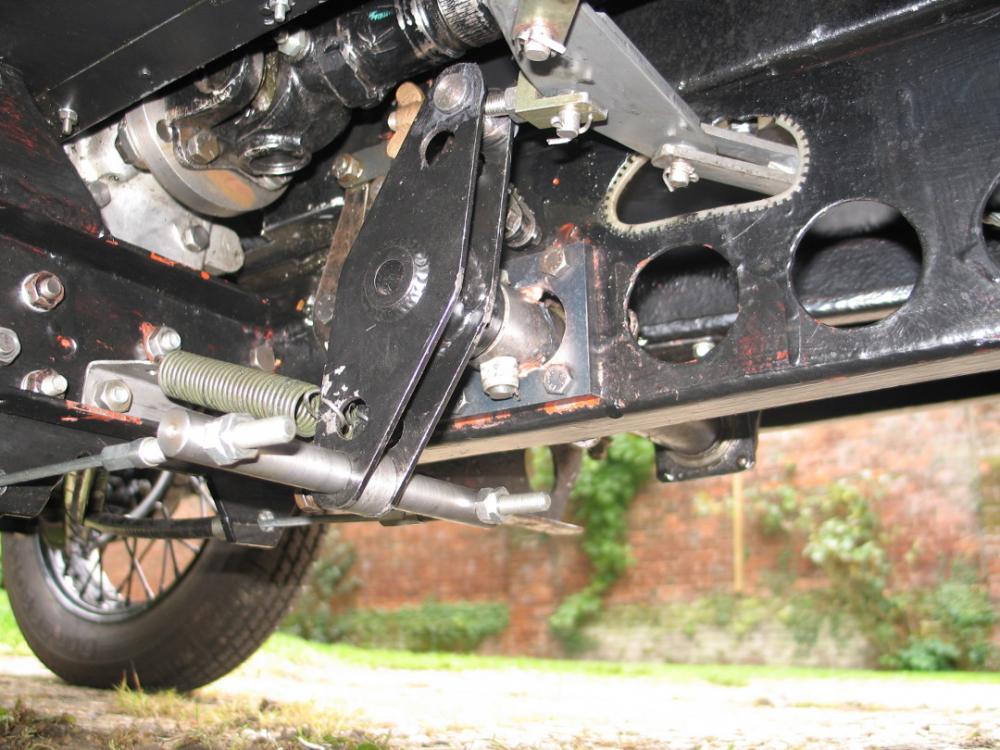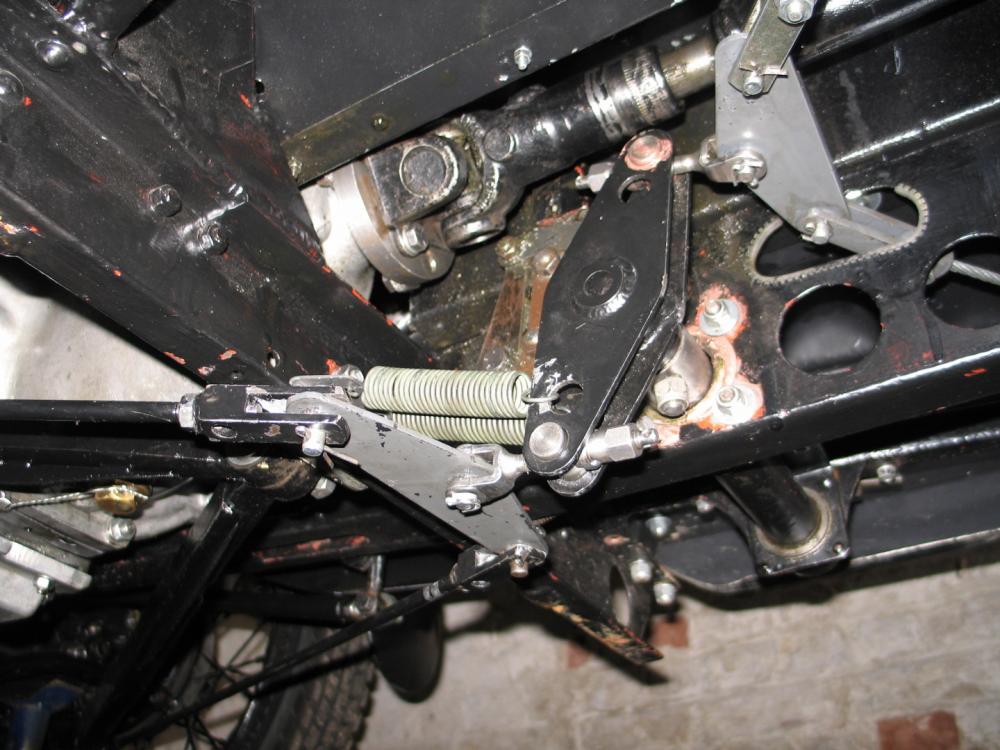Joined: Jun 2018 Posts: 519 Threads: 90
Reputation:
1
02-09-2018, 08:11 PM
(This post was last modified: 02-09-2018, 08:12 PM by Jamie.)
The Austin Seven Companion mentions "Holland Birkett brakes", implying that they are some sort of modification to improve the efficiency of the standard brakes. However, it does not seem to give any details of them elsewhere in the book and I can find nothing when searching online.
Can anyone shed any light on what they are or what the modification is?
Thank you.
Jamie.
Joined: Aug 2017 Posts: 268 Threads: 1
Reputation:
5
(02-09-2018, 08:11 PM)Jamie Wrote: The Austin Seven Companion mentions "Holland Birkett brakes", implying that they are some sort of modification to improve the efficiency of the standard brakes. However, it does not seem to give any details of them elsewhere in the book and I can find nothing when searching online.
Can anyone shed any light on what they are or what the modification is?
Thank you.
Jamie.
Jamie, if your copy of the "Companion" is like mine, you will find half of the original article from the Special Builders Guide on p.81. This is HB's preamble in which he describes the development and failings of the standard braking system.
The missing second half of of the article contains theoretical suggestions for very considerable alterations to the system and a description of a radical redesign which, HB says, he is incorporating (1952) into his as yet uncompleted special. I have no idea if any of these ideas worked.
Regards,
Stuart
Joined: Jun 2018 Posts: 519 Threads: 90
Reputation:
1
(02-09-2018, 10:14 PM)stuartu Wrote: (02-09-2018, 08:11 PM)Jamie Wrote: The Austin Seven Companion mentions "Holland Birkett brakes", implying that they are some sort of modification to improve the efficiency of the standard brakes. However, it does not seem to give any details of them elsewhere in the book and I can find nothing when searching online.
Can anyone shed any light on what they are or what the modification is?
Thank you.
Jamie.
Jamie, if your copy of the "Companion" is like mine, you will find half of the original article from the Special Builders Guide on p.81. This is HB's preamble in which he describes the development and failings of the standard braking system.
The missing second half of of the article contains theoretical suggestions for very considerable alterations to the system and a description of a radical redesign which, HB says, he is incorporating (1952) into his as yet uncompleted special. I have no idea if any of these ideas worked.
Regards,
Stuart
Stuart.
Thank you for the page number. I have just reread that page. I am glad that there is nothing else in the book as I thought that I was being blind.
Regards,
Jamie.
Joined: Apr 2018 Posts: 192 Threads: 76
Reputation:
0
I have "Birkett" compensation on my Ulsteroid.
Essentially the brake cross shaft is located in a normal bearing on the drivers side but only extends to just beyond the longitudinal chassis member where the handbrake is located.
Where the cross shaft passes through this chassis member it runs in a slotted plate made of brass which allows the shaft to move fore and aft but not up and down.
There is then a custom brake lever mounted to the shaft at the centre just adjacent to this slotted plate which has the front brake cable attached via a clevis pin at one end and the rear brakes at the other.
When you apply the brakes the shaft turns until either the front of rear brake cable is in tension and then moves fore and aft along the slot to pull the other cable.
In this way both the front and rear brakes are fully compensating.
Not sure if this all makes sense, I could possibly do a diagram given time.
John.
Joined: Aug 2017 Posts: 3,025 Threads: 171
Reputation:
37
Location: Sherwood Forest
Car type: 1938 Talbot Ten Airline
There was a chassis for sale at this year's Wollaton Park rally with, I think, this modification - did anyone take a photo, perhaps
Joined: Jun 2018 Posts: 519 Threads: 90
Reputation:
1
John,
Thank you for the description of the adaptation on your brakes. It sounds counter-intuitive to have a key component of the systems loose so that it can slide about, but I can see the logic of the idea. I should be grateful if you are able to post a sketch to clarify the modification.
Regards,
Jamie.
Joined: Apr 2018 Posts: 192 Threads: 76
Reputation:
0
I'll try to do it later today and possibly take a couple of photographs if I can get a clear shot of it.
The critical factor in terms of safety is that the length of the slot in the brass plate should be such that if a cable were to break the shaft can only move a limited amount before hitting the end of the slot at which point the shaft will rotate and bring on the brakes at the other end.
In use you can't really notice any movement.
This is the only Austin I've driven so I can't really comment on how it compares with a standard car but the brakes certainly seem fine even in modern traffic.
John.
Joined: Aug 2017 Posts: 66 Threads: 17
Reputation:
0
07-09-2018, 10:05 AM
(This post was last modified: 07-09-2018, 10:56 AM by John Mims.
Edit Reason: Possibly incorrect memory!
)
(06-09-2018, 01:16 PM)John P Wrote: I have "Birkett" compensation on my Ulsteroid.
Essentially the brake cross shaft is located in a normal bearing on the drivers side but only extends to just beyond the longitudinal chassis member where the handbrake is located.
Where the cross shaft passes through this chassis member it runs in a slotted plate made of brass which allows the shaft to move fore and aft but not up and down.
There is then a custom brake lever mounted to the shaft at the centre just adjacent to this slotted plate which has the front brake cable attached via a clevis pin at one end and the rear brakes at the other.
When you apply the brakes the shaft turns until either the front of rear brake cable is in tension and then moves fore and aft along the slot to pull the other cable.
In this way both the front and rear brakes are fully compensating.
Not sure if this all makes sense, I could possibly do a diagram given time.
John.
For what it's worth, this sounds like the conversion often referred to as 'Brewer-French', and described in detail by Jack French in his article 'The Power to Arrest'. It has been discussed at length on the old forum.
John Miles had a modification of this system on his Ulster, which he described as ' Birkett/Rolt'.
The difference lay in the fact that with the Brewer-French system, the brakes are adjusted with the floating cross-shaft sitting in the middle of the slot, so there can be equal compensation front-rear, whereas with the Birkett/Rolt a spring was added to hold the cross-shaft forward in the slot, and the brakes were adjusted to that. When I questioned this, John explained that the theory was that with this adjustment, the front brakes come on first and then the harder they come on, they bring the rears on as well. I'm embarrassed to admit that I only half understood this, but trusted completely his engineering.
I have a photo of this somewhere if it would help.
John
Picture underneath John's car, showing modifications.

From memory, on the next car, there was another triangular plate for the front brake cables, instead of the bar, similar to the rears, to give left/right compensation
...as here

Joined: Jun 2018 Posts: 519 Threads: 90
Reputation:
1
08-09-2018, 09:21 AM
(This post was last modified: 08-09-2018, 09:46 AM by Jamie.)
John and John,
Thank you both for your replies. I shall have a search on the old site for the relevant threads over there as well.
The photos look interesting and make sense, mostly. In the top picture, does the end of the shaft closest to the camera slide about or is it held firmly by a bearing?
Although I am still a long way from working on the brakes, I do want to be fairly clear in my mind how I want to set them up. I am beginning to think along the lines of a couple of balance plates, as shown here, along with Bowden cables to the front and a twin-leading shoe conversion on the front brakes. How viable this is in practice remains to be seen and whether it will be any improvement over the standard system is another matter.
Having searched to no avail, does anyone have a copy of the Jack French article "Power to Arrest" which they would be happy to scan and send to me, please?
Regards,
Jamie.
Joined: Aug 2017 Posts: 66 Threads: 17
Reputation:
0
08-09-2018, 04:09 PM
(This post was last modified: 08-09-2018, 04:39 PM by John Mims.
Edit Reason: Possibly inappropriate
)
(08-09-2018, 09:21 AM)Jamie Wrote: Having searched to no avail, does anyone have a copy of the Jack French article "Power to Arrest" which they would be happy to scan and send to me, please?
I tried to attach a copy to a PM to you, but didn't see how I could. It is too big to attach here, but if you PM me your email, I can send it to you.
(08-09-2018, 09:21 AM)Jamie Wrote: The photos look interesting and make sense, mostly. In the top picture, does the end of the shaft closest to the camera slide about or is it held firmly by a bearing?
As John P said, the inner end of the shortened cross shaft (nearest camera) slides in the slotted bracket bolted to the longitudinal chassis member. In this case it is laser cut from heavy steel plate. In the photo, the cross shaft is at the forward end of its travel. It can slide backwards in the small space visible in the slot. As John P said, limiting the amount of movement is crucial for safety reasons. Jack French discuses this in the article.
Hope this helps
John
PS I think you will find that the slotted bracket is not usually cut from such heavy steel as this one
|




